
(a)
Interpretation:
Determine the structural formula from the given molecular formula:
20 aromatic
Concept Introduction:
The spatial arrangement of atom within a compound that are joined together is identified with the help of structural formula.
Explanation of Solution
The molecular formula C7 H9 N is 20 on the
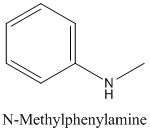
(b)
Interpretation:
Determine the structural formula from the given molecular formula:
30 aromatic amines, C8 H11 N.
Concept Introduction:
The spatial arrangement of atom within a compound that are joined together is identified with the help of structural formula.
Explanation of Solution
Tertiary amines are those compounds in which three hydrogen atoms of ammonia are replaced by alkyl or aryl groups. They are represented as R3 -N or 
The molecular formula, C8 H11 N is 30 on the aromatic amine. Hence, it has six-membered ring. The nitrogen atom is attached to three groups in which one is an aryl group and the other two are methyl groups.
Thus, the structural formula for the molecular formula C8 H11 N is as below:
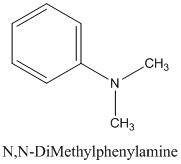
(c)
Interpretation:
Determine the structural formula from the given molecular formula:
10 aliphatic amines, C7 H9 N.
Concept Introduction:
The spatial arrangement of atom within a compound that are joined together is identified with the help of structural formula.
Explanation of Solution
Primary amines are those compounds in which one of the hydrogen atoms of ammonia is replaced by an alkyl or an aryl group. They are represented as 
The molecular formula C7 H9 N is 10 on the aliphatic amine. Hence it has
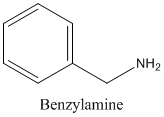
(d)
Interpretation:
Determine the structural formula from the given molecular formula:
A chiral 10 amine, C4 H11 N.
Concept Introduction:
The spatial arrangement of atom within a compound that are joined together is identified with the help of structural formula.
Explanation of Solution
Primary amines are those compounds in which one of the hydrogen atoms of ammonia is replaced by an alkyl or aryl group. They are represented as
The carbon atom attach to four different group is called a chiral atom. When a molecule possesses such atom, then they are not superimposable on their mirror image.
The molecular formula C4 H11 N is 10 on the aliphatic amine, and it is a chiral molecule. Hence, the chiral carbon atom is attached to four different groups, which include -NH2 group, the -CH3 group, the -CH2 group and the -H group. The structural formula of C4 H11 N is as below:
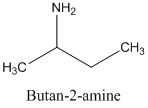
(e)
Interpretation:
Determine the structural formula from the given molecular formula:
A 30 heterocyclic amine, C5 H11 N.
Concept Introduction:
The spatial arrangement of atom within a compound that are joined together is identified with the help of structural formula.
Explanation of Solution
Tertiary amines are those compounds in which three hydrogen atoms of ammonia are replaced by alkyl or aryl groups. They are represented as R3 -N or 
The carbon atom attach to four different group is called a chiral atom. When a molecule possesses such atom, then they are not superimposable on their mirror image.
The molecular formula C5 H11 N is 30 on the heterocyclic amine. This structure has a five membered heterocyclic ring. This ring contains four carbons and one nitrogen atom. The nitrogen atom in the ring is bonded to the methyl group. The structural formula of C4 H11 N is as below:

(f)
Interpretation:
Determine the structural formula from the given molecular formula:
A trisubstituted 10 aromatic amine, C9 H13 N.
Concept Introduction:
The spatial arrangement of atom within a compound that are joined together is identified with the help of structural formula.
Explanation of Solution
Primary amines are those compounds in which one of the hydrogen atoms of ammonia is replaced by an alkyl or aryl group. They are represented as
The molecular formula C9 H13 N is tri substituted 10 on the aromatic amine. Hence, it has six membered rings with three methyl groups. The structural formula of C5 H13 N is as below:
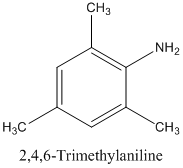
(g)
Interpretation:
Determine the structural formula from the given molecular formula:
A chiral quaternary ammonium salt, C9 H22 NCl.
Concept Introduction:
The spatial arrangement of atom within a compound that are joined together is identified with the help of structural formula.
Explanation of Solution
Quaternary amines are those compounds in which all four of the hydrogen atoms of the ammonium ion are replaced by an alkyl or aryl group. It is an ionic quaternary salt.
When the carbon atom is attached to four different groups, it is called a chiral atom. When a molecule possesses such an atom, then it is not super imposable on its mirror image.
The molecular formula C9 H22 NCl is a quaternary amine and it is a chiral molecule. Hence, the chiral nitrogen atom is attached to four different groups, which include -CH2 CH3 group, the -CH2 CH2 CH3 group, the -CH3 CHCH3 group, and the -CH3 group. Therefore, the quaternary ammonium salt of C9 H22 NCl is as below:
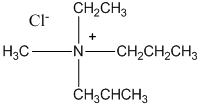
Want to see more full solutions like this?
Chapter 15 Solutions
EP INTRO.TO GENERAL,ORGANIC...-OWL ACCE
- 4. True or false: This skeletal structure represents a saturated fatty acid. Ini to 0 fale) me OH faistong starrow_forwardBy malonic or acetylacetic synthesis, synthesize 5-Methyl-2-hexanone (with the formulas of the compounds).arrow_forwardQUESTION: Answer Question 5: 'Calculating standard error of regression' by filling in all the empty green boxes *The values are all provided in the first photo attached*arrow_forward
- Draw the formula for 3-chlorobenzoic acetic anhydride.arrow_forwardBy malonic or acetylacetic synthesis, synthesize 2-methylbutanoic acid (indicate the formulas of the compounds).arrow_forwardObtain 2-methylbutanoic acid by malonic or acetylacetic synthesis (indicate the formulas of the compounds involved).arrow_forward
- EFFICIENTS SAMPLE READINGS CONCENTRATIONS Pigiadient) TOMATO SAUCE (REGULAR) TOMATO (REDUCED SALT) TOMATO SAUCE (REGULAR) TOMATO (REDUCED SALT) 58 6.274 3.898 301.7 151.2 14150 5.277 3.865 348.9 254.8 B 5.136 3.639 193.7 85.9 605 4.655 3.041 308.6 199.6 05 5.135 3.664 339.5 241.4 0139 4.676 3.662 160.6 87.6 90148 5.086 3.677 337.7 242.5 0092 6.348 3.775 464.7 186.4 PART3 5.081 3.908 223.5 155.8 5.558 3.861 370.5 257.1 4.922 3.66 326.6 242.9 4.752 3.641 327.5 253.3 50 5.018 3.815 336.1 256.0 84 4.959 3.605 317.9 216.6 38 4.96 3.652 203.8 108.7 $3 5.052 3.664 329.8 239.0 17 5.043 3.767 221.9 149.7 052 5.058 3.614 331.7 236.4 5.051 4.005 211.7 152.1 62 5.047 3.637 309.6 222.7 5.298 3.977 223.4 148.7 5.38 4.24 353.7 278.2 5 5.033 4.044 334.6 268.7 995 4.706 3.621 305.6 234.4 04 4.816 3.728 340.0 262.7 16 4.828 4.496 304.3 283.2 0.011 4.993 3.865 244.7 143.6 AVERAGE STDEV COUNT 95% CI Confidence Interval (mmol/L) [Na+] (mg/100 mL) 95% Na+ Confidence Interval (mg/100 mL)arrow_forwardIf we have two compounds: acetone (CH₃COCH₃) and acetic acid (CH₃COOH), applying heat to them produces an aldol condensation of the two compounds. If this is correct, draw the formula for the final product.arrow_forwardIf we have two compounds: acetone (CH3COCH3) and acetic acid (CH3COOH); if we apply heat (A), what product(s) are obtained?arrow_forward
- QUESTION: Fill out the answers to the empty green boxes attached in the image. *Ensure you all incorporate all 27 values (per column)*arrow_forwardYou need to make a buffer by dissolving benzoic acid and sodium benzoate in water. What is the mass of benzoic acid that you would weigh out, in mg, to create 50 mL of a buffer at pH = 4.7 that will change pH no more than 0.10 units with the addition of 0.001 moles of acid or base? Enter just the answer without the units (mg) - just the number will do!arrow_forwardDraw the formula for 3-isopropylcyclopentane-1-carbonyl chloride.arrow_forward
 Introduction to General, Organic and BiochemistryChemistryISBN:9781285869759Author:Frederick A. Bettelheim, William H. Brown, Mary K. Campbell, Shawn O. Farrell, Omar TorresPublisher:Cengage Learning
Introduction to General, Organic and BiochemistryChemistryISBN:9781285869759Author:Frederick A. Bettelheim, William H. Brown, Mary K. Campbell, Shawn O. Farrell, Omar TorresPublisher:Cengage Learning Organic ChemistryChemistryISBN:9781305580350Author:William H. Brown, Brent L. Iverson, Eric Anslyn, Christopher S. FootePublisher:Cengage Learning
Organic ChemistryChemistryISBN:9781305580350Author:William H. Brown, Brent L. Iverson, Eric Anslyn, Christopher S. FootePublisher:Cengage Learning Chemistry: The Molecular ScienceChemistryISBN:9781285199047Author:John W. Moore, Conrad L. StanitskiPublisher:Cengage Learning
Chemistry: The Molecular ScienceChemistryISBN:9781285199047Author:John W. Moore, Conrad L. StanitskiPublisher:Cengage Learning General, Organic, and Biological ChemistryChemistryISBN:9781285853918Author:H. Stephen StokerPublisher:Cengage Learning
General, Organic, and Biological ChemistryChemistryISBN:9781285853918Author:H. Stephen StokerPublisher:Cengage Learning Organic And Biological ChemistryChemistryISBN:9781305081079Author:STOKER, H. Stephen (howard Stephen)Publisher:Cengage Learning,
Organic And Biological ChemistryChemistryISBN:9781305081079Author:STOKER, H. Stephen (howard Stephen)Publisher:Cengage Learning, ChemistryChemistryISBN:9781305957404Author:Steven S. Zumdahl, Susan A. Zumdahl, Donald J. DeCostePublisher:Cengage Learning
ChemistryChemistryISBN:9781305957404Author:Steven S. Zumdahl, Susan A. Zumdahl, Donald J. DeCostePublisher:Cengage Learning





